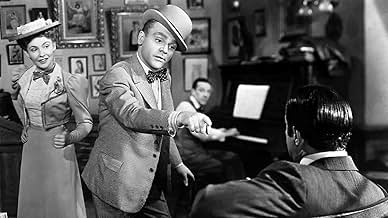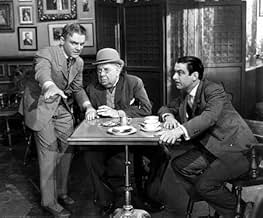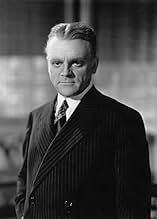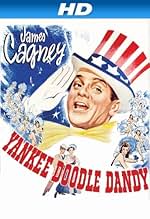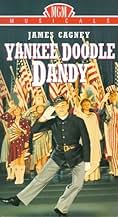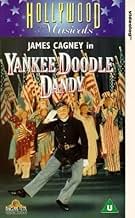IMDb RATING
7.6/10
18K
YOUR RATING
The life of the renowned musical composer, playwright, actor, dancer, and singer George M. Cohan.The life of the renowned musical composer, playwright, actor, dancer, and singer George M. Cohan.The life of the renowned musical composer, playwright, actor, dancer, and singer George M. Cohan.
- Won 3 Oscars
- 9 wins & 6 nominations total
Patsy Parsons
- Josie Cohan - As a Girl of 12
- (as Patsy Lee Parsons)
Featured reviews
James Cagney put down his tommy gun and grapefruit long enough to register his lone Oscar-winning performance in one of Hollywood's most enduring biopics, playing song-and-dance man George M. Cohan with so much gusto it's hard to believe the filmmakers wanted Fred Astaire, or that Cagney ever did anything else but musicals. Cohan himself probably didn't make as good a Cohan as Cagney does here.
The film is best-known for its musical moments, not only because of Cagney's clever hoofing but for the way the numbers are staged. When Cohan debuts his new song "You're A Grand Old Flag," the picture goes from being a relatively straight stage shoot to a series of logistically-improbable montages (a group of Boy Scouts give way to Revolutionary War troops, which melt into a knot of freed slaves gathered around a statue of Lincoln) that sell the history of the United States in all its glory. Finally, as the song winds to its big finish, hundreds and hundreds of uniformed flag bearers spill out on a stage suddenly too big to hold any conventional theater.
The overall effect of this is overwhelming enough to make you want to run out and buy War Bonds 60 years after the conflict "Yankee Doodle Dandy" was inspired by has ended. Patriotism may go out of style from time to time, but events happy and otherwise have a way of bringing it back.
The smaller touches make "Yankee Doodle Dandy" as entertaining as it is inspiring. Little Georgie gets too big for his britches when he tells a Brooklyn audience he can lick any kid in town, and gets put to the test. Older George and a partner beguile a producer (played by S.Z. Sakall, Carl from "Casablanca") into taking on a play no one else wants by pretending it's a hot property. George meets his future wife Mary in old-man costume, and can't resist having a little fun with her. "I know I have talent," Mary blurts, "even if I am from Buffalo."
Cagney does talk rather fast, and he needs to if only to keep pace with a frenetic storyline. Situations change rather quickly in "Yankee Doodle Dandy," and sometimes, as with George's sudden success and the later dissolution of the Four Cohans, it happens a bit too fast to follow. Cagney hardly pauses for breath. He's no singer, either, talking his way through his numbers like Rex Harrison in "My Fair Lady," only not as well.
But few films deliver the goods like "Yankee Doodle Dandy." You get a strong feeling for vaudeville entertainment, how mass entertainment worked in the gaslight age. The musical numbers (all done within the context of public performance, or else rehearsal, i.e. naturalistically) have real charm. The dialogue is great, too, a trifle canned and buffed-up maybe, but very Runyon-ish in its Stage Door Johnny way.
The best scene, for Cagney's acting and for comedy, is when he shows Mary a new song he wrote for her. The way his eyes move from her face to the score, prompting her unnecessarily, reveals both affection and the showman's inner ham. He almost looks menacing, but of course it's because he's smitten by the singer and trying to tell her through his song. It also sets up a great bit of comedy later on when George has to give Mary's song away to stage star Fay Templeton, then go back and explain it to Mary.
"He's the whole country squeezed into one pair of pants," exclaims one producer trying to get Templeton to hitch her wagon to Cohan's star. With Cagney wearing the pants, the end result is a perfect fit.
The film is best-known for its musical moments, not only because of Cagney's clever hoofing but for the way the numbers are staged. When Cohan debuts his new song "You're A Grand Old Flag," the picture goes from being a relatively straight stage shoot to a series of logistically-improbable montages (a group of Boy Scouts give way to Revolutionary War troops, which melt into a knot of freed slaves gathered around a statue of Lincoln) that sell the history of the United States in all its glory. Finally, as the song winds to its big finish, hundreds and hundreds of uniformed flag bearers spill out on a stage suddenly too big to hold any conventional theater.
The overall effect of this is overwhelming enough to make you want to run out and buy War Bonds 60 years after the conflict "Yankee Doodle Dandy" was inspired by has ended. Patriotism may go out of style from time to time, but events happy and otherwise have a way of bringing it back.
The smaller touches make "Yankee Doodle Dandy" as entertaining as it is inspiring. Little Georgie gets too big for his britches when he tells a Brooklyn audience he can lick any kid in town, and gets put to the test. Older George and a partner beguile a producer (played by S.Z. Sakall, Carl from "Casablanca") into taking on a play no one else wants by pretending it's a hot property. George meets his future wife Mary in old-man costume, and can't resist having a little fun with her. "I know I have talent," Mary blurts, "even if I am from Buffalo."
Cagney does talk rather fast, and he needs to if only to keep pace with a frenetic storyline. Situations change rather quickly in "Yankee Doodle Dandy," and sometimes, as with George's sudden success and the later dissolution of the Four Cohans, it happens a bit too fast to follow. Cagney hardly pauses for breath. He's no singer, either, talking his way through his numbers like Rex Harrison in "My Fair Lady," only not as well.
But few films deliver the goods like "Yankee Doodle Dandy." You get a strong feeling for vaudeville entertainment, how mass entertainment worked in the gaslight age. The musical numbers (all done within the context of public performance, or else rehearsal, i.e. naturalistically) have real charm. The dialogue is great, too, a trifle canned and buffed-up maybe, but very Runyon-ish in its Stage Door Johnny way.
The best scene, for Cagney's acting and for comedy, is when he shows Mary a new song he wrote for her. The way his eyes move from her face to the score, prompting her unnecessarily, reveals both affection and the showman's inner ham. He almost looks menacing, but of course it's because he's smitten by the singer and trying to tell her through his song. It also sets up a great bit of comedy later on when George has to give Mary's song away to stage star Fay Templeton, then go back and explain it to Mary.
"He's the whole country squeezed into one pair of pants," exclaims one producer trying to get Templeton to hitch her wagon to Cohan's star. With Cagney wearing the pants, the end result is a perfect fit.
The amazing piece of timing here is when Warner Bros. began work on this biography of entertainer George M. Cohan, WWII had not yet broken out. The attack on Pearl Harbor occurred the day before shooting began. When the film opened people on the home front badly needed some morale boosting, and this film gave it to them. It's just a joyous musical costume piece from start to finish with nice comic touches balanced with some sentimental moments (supposedly Walter Huston's deathbed scene had even taskmaster director Michael Curtiz crying). There's nothing in the way of real conflict or even much heavy in the way of romance between Cohan and his fictitious film wife "Mary", who was modeled after Cohan's actual second wife in some ways. Cohan was actually married twice. Oddly enough, it was Cohan who said he wanted as little romance in the film as possible.
The more I learn about Cohan the more I realize that Cagney was perfect to play him - both Irish Americans, both about the same size and build, and George Cohan's style of dancing and singing were about the same as Cagney's. It's hard to believe that Fred Astaire was Cohan's first choice to play himself. Astaire was a great talent, but I don't think he could have conveyed the combination of mischief, optimism and energy that was Cohan the way that Cagney ultimately did. Several people criticize Cagney's dancing here, but that eccentric style was Cohan's, who always considered himself more of an overall entertainer than a dancer in the first place.
If you're "date conscious" as I am, there are some matters of plot that might bother you. Cohan was born on July 2 or 3, not July 4. Cohan's mother outlived his father by eleven years and Cohan's father was not "very old" when he died as is said in the film - at least by today's standards. When Cohan's father died in 1917, he was only 69. Cohan's sister did die young - she was only 39, dying in 1916, plus she was not his little sister. Instead Josie was a year older than George. The film has Josie marrying when she would have been close to forty, when she actually married at the beginning of the 20th century and thus was the one to break up the four Cohans, not George. Also, Cohan received his Congressional Medal in 1936, not as WWII began as shown in the film. However the plot device of having George M. recount his life story to FDR, receiving his Congressional medal in the Oval Office, and then dance joyously down the White House stairs and into the streets joining a group of marching soldiers in a chorus of "Over There" was probably a great way to bridge Cohan's patriotic past with what was then an uncertain time that certainly needed a dose of his optimism.
The one thing that I did find a little odd - and one thing isn't much in a two plus hour long movie - is that it is hard to spot the actual point in the film where Mary becomes George's wife. There is quite a bit of domesticity shown before the two were married. Mary is cooking for George, staying in his apartment alone waiting for him to come home from the show, and acting very much like they are already married. The only way you know they are not is that George very subtly pops the question to the point that I'm surprised even Mary knew what he was asking! I know this doesn't seem like much in today's world, but considering that they were trying to paint Cohan in the most positive light possible and that the living arrangements might be misunderstood, I am surprised that the censors of that time never raised the issue.
At any rate, I highly recommend this one. You'll have a great time, at least in part because you can see that Cagney is having a great time. He always said this film was his favorite, and it shows in his performance.
The more I learn about Cohan the more I realize that Cagney was perfect to play him - both Irish Americans, both about the same size and build, and George Cohan's style of dancing and singing were about the same as Cagney's. It's hard to believe that Fred Astaire was Cohan's first choice to play himself. Astaire was a great talent, but I don't think he could have conveyed the combination of mischief, optimism and energy that was Cohan the way that Cagney ultimately did. Several people criticize Cagney's dancing here, but that eccentric style was Cohan's, who always considered himself more of an overall entertainer than a dancer in the first place.
If you're "date conscious" as I am, there are some matters of plot that might bother you. Cohan was born on July 2 or 3, not July 4. Cohan's mother outlived his father by eleven years and Cohan's father was not "very old" when he died as is said in the film - at least by today's standards. When Cohan's father died in 1917, he was only 69. Cohan's sister did die young - she was only 39, dying in 1916, plus she was not his little sister. Instead Josie was a year older than George. The film has Josie marrying when she would have been close to forty, when she actually married at the beginning of the 20th century and thus was the one to break up the four Cohans, not George. Also, Cohan received his Congressional Medal in 1936, not as WWII began as shown in the film. However the plot device of having George M. recount his life story to FDR, receiving his Congressional medal in the Oval Office, and then dance joyously down the White House stairs and into the streets joining a group of marching soldiers in a chorus of "Over There" was probably a great way to bridge Cohan's patriotic past with what was then an uncertain time that certainly needed a dose of his optimism.
The one thing that I did find a little odd - and one thing isn't much in a two plus hour long movie - is that it is hard to spot the actual point in the film where Mary becomes George's wife. There is quite a bit of domesticity shown before the two were married. Mary is cooking for George, staying in his apartment alone waiting for him to come home from the show, and acting very much like they are already married. The only way you know they are not is that George very subtly pops the question to the point that I'm surprised even Mary knew what he was asking! I know this doesn't seem like much in today's world, but considering that they were trying to paint Cohan in the most positive light possible and that the living arrangements might be misunderstood, I am surprised that the censors of that time never raised the issue.
At any rate, I highly recommend this one. You'll have a great time, at least in part because you can see that Cagney is having a great time. He always said this film was his favorite, and it shows in his performance.
So it takes liberties with facts. So it's jingoistic. Big deal! I adore it for its depiction of turn-of-the-(20th}century New York, especially its theater, which has fascinated me for years. And it has the breath-taking performance of Jimmy Cagney in the title role; he's absolutely elecrifying in the musical numbers. If some scenes are mawkish, well, I think that can be forgiven.
This movie, above all others, make me so proud to be an American.
This movie, above all others, make me so proud to be an American.
Right from the start, I have to say you do not need to be an American to be caught up in the excitement of the blatant flag waving tribute to a great artist. "Yankee Doodle Dandy" made to boost morale after the U.S. entered the war surely would have achieved its goal. It would have been even better in Technicolor (not the coloured version later shown). The songs were great, the acting and the individual dancing style of James Cagney was superb and deserved the Oscar. The two scenes featuring "Over There" were very moving with Frances Langford a standout! The story, while bearing small resemblance to real life, was good and Walter Huston and Rosemary de Camp were excellent. When you see a film such as this some 60 years after its release, and still really enjoy it, it shows how the Golden Years of Hollywood were just that.
There are many, many James Cagney films that show his enormous talent as an actor. He was equally at home in musicals, dramas and comedies. While I have always been a fan and appreciate his unusual scope, this movie in particular caught my eye and totally blew me away when the scene I'm about to describe unfolded.
Near the very end of the film Cagney's character (George M. Cohan) bids farewell to the President and leaves the room. There is a long, open staircase he starts walking down. As he walks you sense a bit of a bounce beginning to take over his step.....one that quickly gives way to an awesome dance as he navigates the stairway. Many will not note, but this dance was a fantastic achievement on two fronts. One, it was done in one "take"...that is, the camera never stopped; the scene never "cut." The camera stays with him in one shot all the way through. Second, Mr. Cagney never ONCE looks at his feet or down at the steps. It's almost impossible to WALK down a staircase without looking down or hanging on to a banister....this man DANCED down a staircase without benefit of seeing or touching anything.
Couple this feat with the brilliant display of "hoofing" he gives earlier in the film when he literally dances up the walls and you have a movie that deserves its "classic" rating. If you haven't seen it please make it a point to do so. Any movie that is awe inspiring 62 years later must be worth a peek, don't you agree?
Near the very end of the film Cagney's character (George M. Cohan) bids farewell to the President and leaves the room. There is a long, open staircase he starts walking down. As he walks you sense a bit of a bounce beginning to take over his step.....one that quickly gives way to an awesome dance as he navigates the stairway. Many will not note, but this dance was a fantastic achievement on two fronts. One, it was done in one "take"...that is, the camera never stopped; the scene never "cut." The camera stays with him in one shot all the way through. Second, Mr. Cagney never ONCE looks at his feet or down at the steps. It's almost impossible to WALK down a staircase without looking down or hanging on to a banister....this man DANCED down a staircase without benefit of seeing or touching anything.
Couple this feat with the brilliant display of "hoofing" he gives earlier in the film when he literally dances up the walls and you have a movie that deserves its "classic" rating. If you haven't seen it please make it a point to do so. Any movie that is awe inspiring 62 years later must be worth a peek, don't you agree?
Did you know
- TriviaMany facts were changed or ignored to add to the feel of the movie. For example, the real George M. Cohan was married twice, and although his second wife's middle name was Mary, she went by her first name, Agnes. In fact, the movie deviated from the truth to such a degree that Cohan's daughter Georgette commented, "That's the kind of life Daddy would have liked to have lived."
- GoofsThe "You're A Grand Old Flag" number, supposedly takes place in the 1906 production of "George Washington Jr.," and uses multiple period flags to represent times before 1906. The Civil War flag, as an example, is correct for the time in question. However, in the final sequence characters carry, and an soft screen projection is made of, multiple 48 star flags. The 48 star flag was not introduced until 1912. In 1906, it should have been a 45 star flag. (Oklahoma was admitted to the Union in 1907, New Mexico and Arizona in 1912).
- Quotes
George M. Cohan: My mother thanks you, my father thanks you, my sister thanks you, and I thank you.
- Alternate versionsAlso available in a computer colorized version.
- ConnectionsFeatured in The Voice That Thrilled the World (1943)
- SoundtracksThe Yankee Doodle Boy
(1904) (uncredited)
from the Broadway Show "Little Johnny Jones"
Written by George M. Cohan
Played during the opening credits
Sung and Danced by James Cagney and Chorus
- How long is Yankee Doodle Dandy?Powered by Alexa
Details
- Release date
- Country of origin
- Language
- Also known as
- El canto de la victoria
- Filming locations
- Production company
- See more company credits at IMDbPro
Box office
- Gross US & Canada
- $11,800,000
- Runtime2 hours 6 minutes
- Color
- Aspect ratio
- 1.37 : 1
Contribute to this page
Suggest an edit or add missing content




